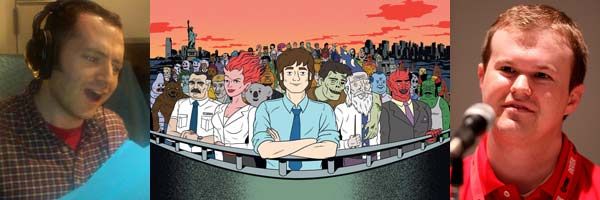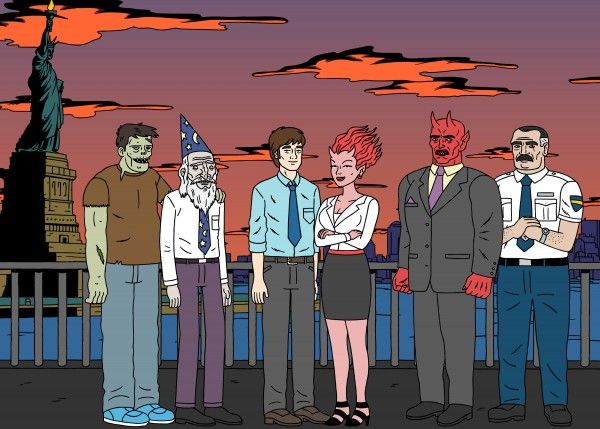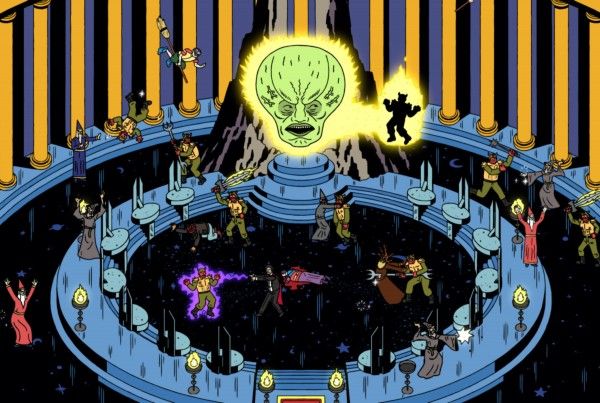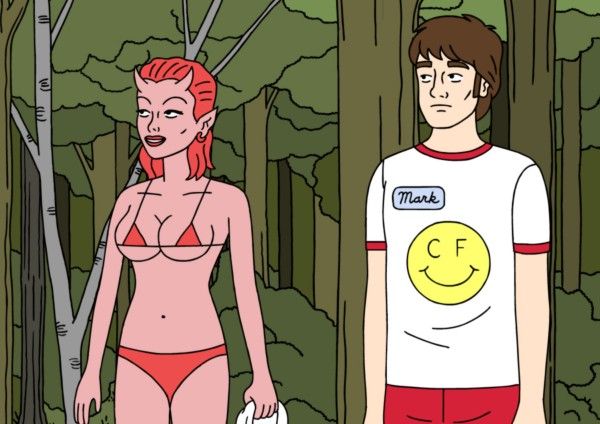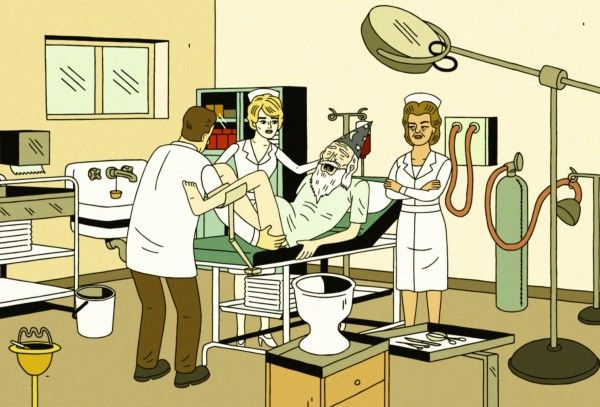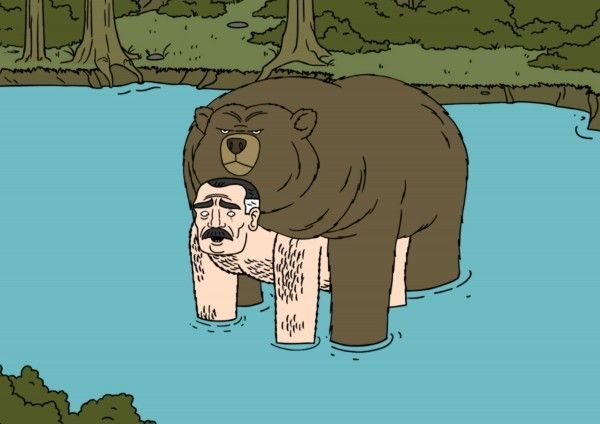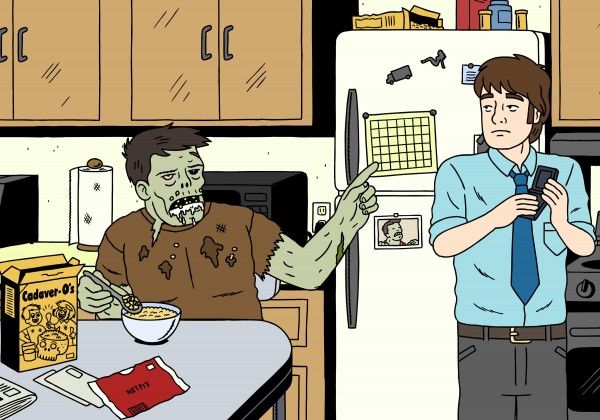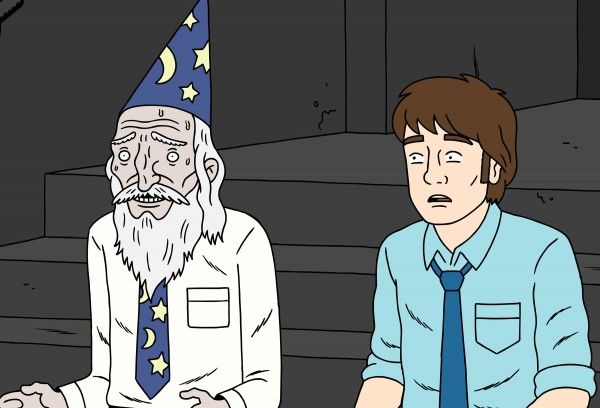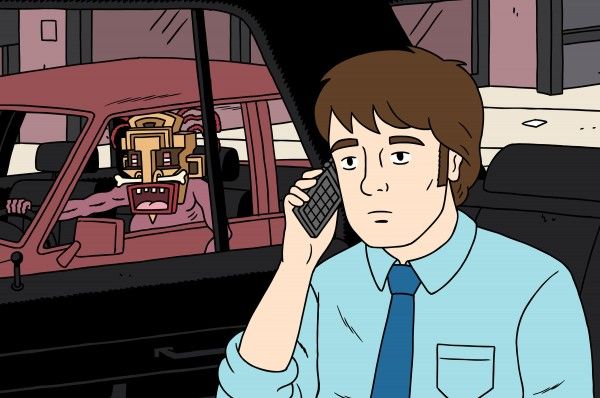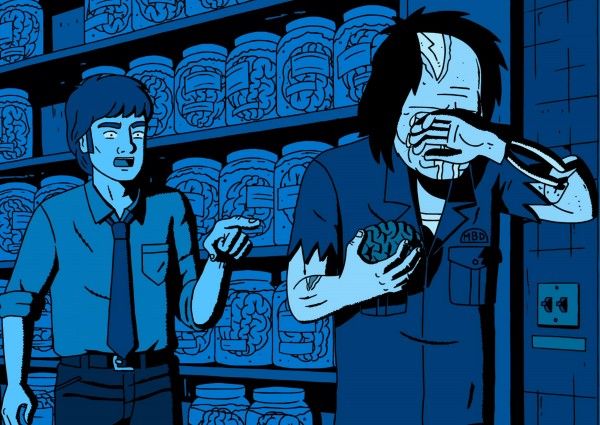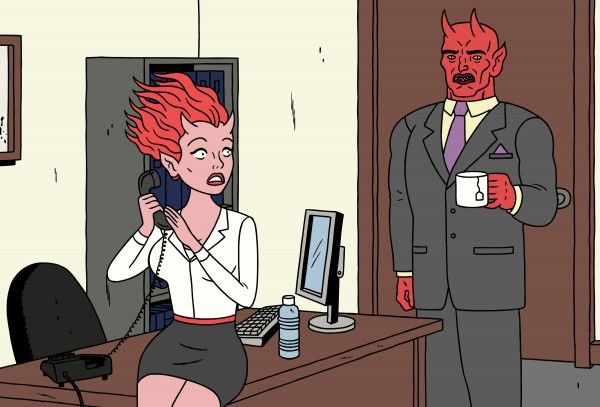The animated horror-comedy Ugly Americans – set in a New York City filled with every beast, creature and freak – follows Mark Lilly (voiced by Matt Oberg), a social worker at the Department of Integration, as he helps new citizens, both human and “other,” adapt to hectic life in the Big Apple. Between his stressful job – which includes weaning vampires off of blood and housebreaking werewolves – a zombie roommate and a demon girlfriend, Mark’s lucky if he can sneak in a few minutes of sleep.
During a recent exclusive phone interview with Collider, show creator Devin Clark and executive producer Daniel Powell talked about bringing this wacky and weird world to life, the challenge of keeping the issues relatable, developing the look of the animation, what they learned from Season 1, the themes they’re exploring in Season 2, how the talented and very funny voice actors influence the characters and story, their great guest voices, and trying not to have too much fun, at the expense of the show. They also talked about the recently developed downloadable video game, Apocalypsegeddon, that is an extension of the series. Check out what they had to say after the jump:
Question: How did this series originally come about for each of you? Did a lot of thought go into how you could establish this world, from the very beginning, so that you could sustain it for a number of seasons?
DEVIN CLARK: No, not at all, actually. It was born out of a simple idea. I was killing time. Being an artist and illustrator, I’m always compulsively drawing in my sketchbook, and I had been doing these big comic book pages, where I would break the page into eight panels and fill them up with eight of the same type of monster, talking about a specific topic. So, I did eight robots talking about the economy, and eight demons talking about religion. More than anything, it was just born out of this desire to draw weird, crazy creatures. I pitched it to Comedy Central as a man-in-the-street, interview style web show, where they interviewed these monsters on topics like presidential candidates and immigration, and stuff like that. So, I think that idea of treating horrific creatures as normal citizens is what became the premise of Ugly Americans. We inadvertently were tapping into such a broad, crazy spectrum of horror, fantasy and sci-fi creatures that it gave us endless possibilities on what that scenario would be like to have to normalize this type of creature, via Mark Lilly (Matt Oberg), to live amongst us in society. It was really just born out of my own selfish desire to draw crazy creatures, though.
DANIEL POWELL: Basically, I was a development executive at Comedy Central and Devin came in, in 2006. We were doing original web content, at the time, for ComedyCentral.com and Devin pitched a little web series that he wanted to do, that was originally called Eight-On and we shrunk it to Five-On because web series have to be shorter. Normally, when I would get pitched TV shows or web series, someone would walk me through the idea and maybe they had some paper where they typed out their thoughts on it, but Devin was the first person who actually pitched me comic strips, which was really interesting because TV is a visual medium and he was the first person to pitch something actually showing me the visuals. He laid it all out, and I just immediately laughed at all of his really unique character designs and illustrations. They just immediately caught my eye and made me laugh without even reading the dialogue that he had. And then, we ended up doing the web series and the style of those webisodes took these fantastical and absurd-looking creatures and totally normalized them, as if they were just everyday characters going about their lives and talking about really mundane subjects. It was extremely funny and really well done. The format of the web shows was more of a man-on-the-street thing, and that couldn’t sustain at a half-hour, but what I really liked was the tone and the world. At the time, Comedy Central had picked up Futurama in acquisitions. They hadn’t started doing new episodes yet, but it was doing really well in repeats. I pitched it to the higher-ups at Comedy Central as a potential horror companion to what Futurama is to sci-fi. So, we took the general tone and concept and fleshed it out into more of a traditional character-based sitcom. David Stern, a former writer for The Simpsons, handled that. We’ve come full-circle now that we’re actually behind Futurama. Originally, we launched behind South Park, but the concept was, in its initial stages, to be a horror companion to Futurama, and now that we’re behind Futurama, the whole idea has come full-circle.
What were the most challenging aspects in creating this whole world?
POWELL: The hardest part is always striving to keep the issues relatable and normalize the tone. There are a lot of bizarre characters and strange creatures, either from mythological folklore or that we’ve just made up entirely. But, the goal is ultimately to tell stories that do actually have some sort of relation to things that we face in our everyday world, whether we’re doing commentary on a larger social issue like immigration, or we’re commenting on things that people face in their everyday lives like meeting your girlfriend’s parents. In the pilot episode, Mark had to meet his girlfriend’s father, and to do so, he literally has to go to Hell because his girlfriend is literally a demon and her father is literally the Devil. Ultimately, that core theme of being terrified of meeting your girlfriend’s parents is relatable to everyone. It’s always about trying to strike that balance of mixing the weird with something that the audience can latch onto, and Mark’s character is all about being a straight man that’s your eyes and ears into this bizarre world. If Mark was a ghoul or a zombie himself, I think it would be really difficult to hang your hat on anything in the show. It would all just be way too out there. It’s nice to have a straight man to react to everything. And then, setting the show in New York City, in this world large enough where you could have endless creatures coming in and out of Mark’s life, is the key to keeping it sustainable.
How did you decide on the look of the animation for the series?
CLARK: Well, when I first was talking to Dan Powell – who was the executive producer at Comedy Central involved in development, and is now a producer on the show – about who should do the pilot, for him and I, our first choice was Augenblick Studios, just because we knew they could pull off that inky, comic book feel. Aaron Augenblick runs his studio very much like a traditional animated studio where, rather than doing puppeted animation, they’re really hard core about doing that classic, in betweening. Every movement is drawn. It was really important for us to have that hand-drawn look for the show, and we knew his studio could pull it off.
In doing the first season, were there things that you learned that you were able to carry over and apply to Season 2?
CLARK: Yeah, definitely. We were really worried about how crazy a world it was, so when we were doing the first season, we wanted to make sure that there was a very good sense of grounding in the formula of how we were approaching each episode. We did a monster-of-the-week thing, where we had one individual that Mark would have to help usher through the system of being integrated, so we set it up with the premise of the cold open, which always had this horror misdirect. We would always have Grimes (Larry Murphy) arrest the person, and then we’d have the court scene, and then we’d have Mark being put in charge of helping to rehabilitate the person or integrate them. After the first season, we realized that we didn’t need to keep hitting that formula over the head. People already get the premise of the show, and they understand that this is a crazy world with weird creatures, so we wanted to take the opportunity to delve deeper into the six main characters and how they fit within this world and what makes them weird or quirky, find out why Mark is always trying to fix people and what draws him into an obviously dysfunctional relationship with Callie (Natasha Leggero), and delve a little deeper into Leonard’s (Randy Pearlstein) crazy background since he’s been around for 700 years. We figured out that people can roll with it a lot better than maybe we thought they could, and checking out these six main characters would be something a little more interesting for the second season. This season is pretty crazy, so keep watching. We go some bizarre places.
POWELL: The characters always evolve, as you go on. Frankly, a lot of it is what the voice actors bring to the characters that they’re doing. Michael-Leon Wooley, who voices Twayne, has probably been the most responsible for how a performance affects the way a character evolves. He has this amazing range, where he can be totally terrifying, and then just turn on a dime and be completely baffoon-ish, effeminate and absurd, so it made Twayne into this more silly character who veers between being this terrifying demon bureaucrat and just being a total doofus. It’s just a matter of taking one episode at a time and collaborating with the writers and the voice performers and seeing where you can take the character without straying too far from what you had originally intended.
Have there been characters that ended up standing out for you because of the actor’s performance, that led you down a different path with them than you originally thought they might go?
CLARK: Definitely. Probably the first instance with that was the zombie roommate Randall, voiced by Kurt Metzger. When we were doing the casting for that, in the pilot even, the original design for that dead-beat roommate character was something we imagined with a Boston accent. When Kurt came in and spoke for the role, we were like, “Oh my god, this guy is the guy. He has to be the guy!” So, we totally redesigned the character to be built like Kurt. It’s like zombie-fied Kurt Metzger, so we made him a much bigger, heavy-set guy. The actors bring a huge amount to the roles, and we try to adjust accordingly. There’s a lot of feedback, both ways. Sometimes the design of the character informs which direction the actors are going to take, and sometimes vice versa.
Do you have to keep things a bit fluid then, with so many actors doing voices on the show, who are comedians and comedy writers themselves?
POWELL: We definitely leave room for improvisation. There are certainly things that we find in the voice recording, or even the table read, and we make adjustments based on that. Sometimes, especially with Kurt Metzger, who is not actually an improviser by trade, but who is just really good at coming up with things in his own voice, right on the spot, we’ll just put, “Let Kurt ad-lib,” in the script. Whatever he can come up with, off the top of his head, will probably be filthier and funnier than the things that we can write in there.
Were there themes for the stories that you wanted to explore at all?
CLARK: I don’t know. Since I have less involvement in the writing side, and more in the visual side – I direct most of the episodes and do a lot of the character design – for me, it’s always a fun opportunity to see what other worlds I can pull from, even beyond horror. We had some really fun opportunities this season to pull from old ‘70s cop shows. We found out that Grimes used to be a cop back in the ‘70s, and we had all these crazy flashbacks, as he’s uncovering these repressed memories about some terrible psychological incidents that happened to him as a cop. So, it’s fun for me just to step out and try lots of different styles and looks. I’m excited for whatever the writers throw at me, thematically. It’s just a new opportunity to try something different.
In creating these characters, what’s it like to see the guest voices come in and bring them to life?
CLARK: Oh, I love it! It’s a dream come true. It’s really phenomenal. We’ve really lucked out and had some funny people. Even our core cast of actors are phenomenal. Most of them are stand-up comedians or great improvisers, and what they bring to the show is priceless. And then, within the first season, we were able to get all these SNL people to just hop on board, even though we were an unproven show and a new thing, which was just super-exciting. We have Christine Baranski playing Grimes’ mom. She’s a mummy, back from the dead, here to go over parent-child boundaries and ruin his life, in an attempt to give him more discipline, which he obviously needs. She was just hilarious. She made a joke about how much fun it was and how they never let her scream and holler like that on The Good Wife, so she was psyched for the opportunity.
Who are some of the other guest voices that you’ll be having this season?
POWELL: We have Rob Riggle, from The Daily Show and Saturday Night Live, come in and do some stuff, and he was amazing. He plays a drill Sergeant, which was great because he’s a former Marine, so it was a perfect role for him. He totally committed and was hilarious. Jenny Slate, who was on Saturday Night Live, did a voice. She’s playing Mark’s ex-girlfriend, who comes back into his life and makes him question his relationship with Callie. She was hysterical. And, the stand-up comedian Todd Barry came in and played a sexually inadequate dragon. Just the contrast between Todd’s voice and the fact that he was playing a theoretically fearsome creature was really funny.
Is there anyone that you’d just love to get to do a voice on the show?
POWELL: Honestly, it’s hard for me to name anyone specific. I worked with Jon Benjamin once before on a show, and he just has the funniest voice in show business. He’s the lead voice on Archer and Bob’s Burgers, but it would be nice to have him come in. And, perhaps David Cross. He has such a unique voice, I’d love to get him in to do some stuff.
When you have to think ahead in terms of months, because it takes time to make the episodes of the series, how does that effect things, in order to keep things relevant or to allow for you to go back and change or add something, if you need to?
CLARK: It certainly makes it a little more challenging because we don’t have as quick a turn-around as some other shows do, to be relevant to whatever joke is happening, in that week. We try to have jokes that are going to last a little longer. A big thing for us is the layering of comedy. We want people to be able to go back and pick up on all the little, weird background gags that they didn’t pick up on, the first time. So, you want to make sure the jokes can stand the test of time, for those repeat viewings, months down the road. The one advantage of animation is that it’s a lot easier to do “retakes.” If we do need to adjust, we can just tap one of the animators on the shoulder and have them do a slight little adjustment or put in a new joke, here and there. It’s not as crazy as having to go out and do some reshoot with actors and lighting and everything. We just have to make sure we have an animator on hand, who can stay until three in the morning to fix a scene.
POWELL: We certainly can’t be as hyper-topical as South Park is ‘cause we can’t turn the show around nearly as fast, and we can’t be as topical as The Daily Show because their episodes only repeat for 48 hours tops, before they have a new episode. With us, we like to be as relevant as we can, but with nine months lead time, we unfortunately can’t be as topical as those shows can be, so we try to look at overall themes that we know won’t have gone away in a year from then, whether it’s the environment or race relations, or things like that, that are an on-going conversation in our society. We also try to hit pop culture touchstones that we know will not have faded from the public spotlight, by the time it airs. We made fun of Twilight in our first season. We knew that wasn’t going to go anywhere for awhile. This season, in our season premiere, we had some fun at Harry Potter’s expense. When we looked at the airdates, we knew that the final movie would be coming out, shortly after the episode aired, so it would seem like we were hyper-topical, even though we had a good nine months advance notice.
How much fun is it to make a show like this where it seems like anything has been fair game? Have you ever come up with anything that’s been too outrageous, that you decided not to do?
CLARK: I don’t know if there’s anything that’s been too outrageous that we decided not to do. I think the trick is always, “How are we going to do it?” The prime example of that is the last episode of the second half of our first season with the man-birds. Initially, it was pitched as, for all the man-bird cockfighting, they literally were fighting with their cocks, and the network was like, “No way! This is not going to fly.” So, we built in this whole patch scene, where they’re walking through the museum and they discus their “cocks,” but that’s not their genitals, that’s a protective sheath that’s over the top of their genitals. Just by explaining that and laying that groundwork down for the audience and for the legal department of Comedy Central, we could get away with what is clearly birds hitting each other in the face with their penises. It’s always fun. And sometimes, within the challenge of doing a work-around, you come up with something a lot more creative and a lot more perverse, in its own way. It opens up the imagination and makes it more specific to our world. I always enjoy the challenge of working our way around the standards, just because I think it forces us to come up with something a little funnier and a little more creative.
POWELL: It is an interesting challenge to balance just how much fun it is to have this pop culture smorgasbord of things that you can make fun of. We’ve created this world where we can really target so many things in pop culture and have fun with them, but we also have to always check ourselves against getting too self-indulgent or too inside geek culture. We want to tell stories that are relevant and have some semblance of story structure and character development, and things like that. Ultimately, that’s what keeps people coming back to a show. They start to develop an affinity for the characters and they trust that they stories being told are going to be satisfying, on some level. It’s extremely fun, and sometimes we have to make sure that we’re not having too much fun at the expense of the key ingredients that make the show work.
How did the video game, Apocalypsegeddon, come about and what was it about that medium that you thought would be a good companion to the show?
CLARK: I don’t know if it was ever approached as an interesting way of extending the narrative part of the world of Ugly Americans. I think it was more exciting to just see it built out in a much broader scale. The fact that the video game company took all of our original backgrounds and character designs and actually built them out in 3D, so that it feels like you’re literally walking down the street within the show, was the most exciting part for me. I don’t know how deep we get into any of the mythology, or anything like that. It’s definitely a shooter game. But, the exciting part is that you feel totally immersed within our version of New York that we’ve created.
POWELL: Comedy Central approached us with the idea for the game. It was 100% their idea. They were looking to make a downloadable game, and the world of Ugly Americans seemed pretty natural, in terms of translation to a game, and they were totally correct. They had in mind a rough idea for what they wanted the game to be, so we didn’t have to spend too much time thinking of what exactly the actual style of the game would be and what the structure would be. They gave us the rough structure and then worked with us on the story we could tell around the game play to make it interesting. The most interesting thing to me was watching them take the world that we had created in 2D and render it into this interactive, 3D environment. They were shockingly faithful. They used all of the elements that we gave them. Their attention to detail was extraordinary, so I have to really hand it to those guys. I’ve played it a couple of times and I really cannot believe it’s a $10 downloadable game. Maybe it’s because I’m older and I’m used to games being like Super Mario Bros.

